MARKETING
15 of the Best Free Website Builders to Check Out in 2023
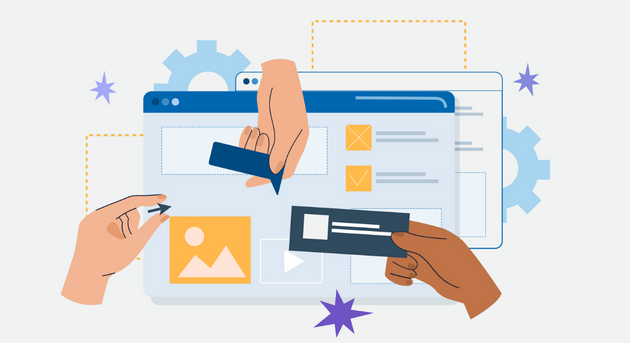
In today’s digital world, having a business website isn’t an option. It’s a must.
An online presence is the digital equivalent of a calling card or listing on a phone book’s yellow pages. It increases brand awareness and allows you to display products and services online.
Unfortunately, not all businesses see the benefit of having a website. A survey commissioned by Top Design Firms found that 27% of small businesses don’t have one — and the top reasons holding them back from getting one are cost and lack of technical know-how.
But here’s the good news: there are plenty of high-quality options for free website builders, many of which require little to no coding knowledge.
If you don’t know where to look, don’t worry. We’ve compiled 14 of the best free website builders. They offer robust functionality like SEO benefits, embedded analytics systems, mobile optimization, and professional-looking templates.
These builders are the next best thing if you’re on a tight budget. Better yet? Most of the free website builders we’ll show you have paid options if you need additional features as your business grows.
Best Free Website Builders
- HubSpot Drag-and-Drop Website Builder
- Wix
- WordPress.com
- Elementor Website Builder
- Webnode
- Jimdo
- Mozello
- Yola
- Weebly
- Webflow
- Ucraft
- SITE123
- Strikingly
- GoDaddy
- Appy Pie Website
1. HubSpot Drag-and-Drop Website Builder
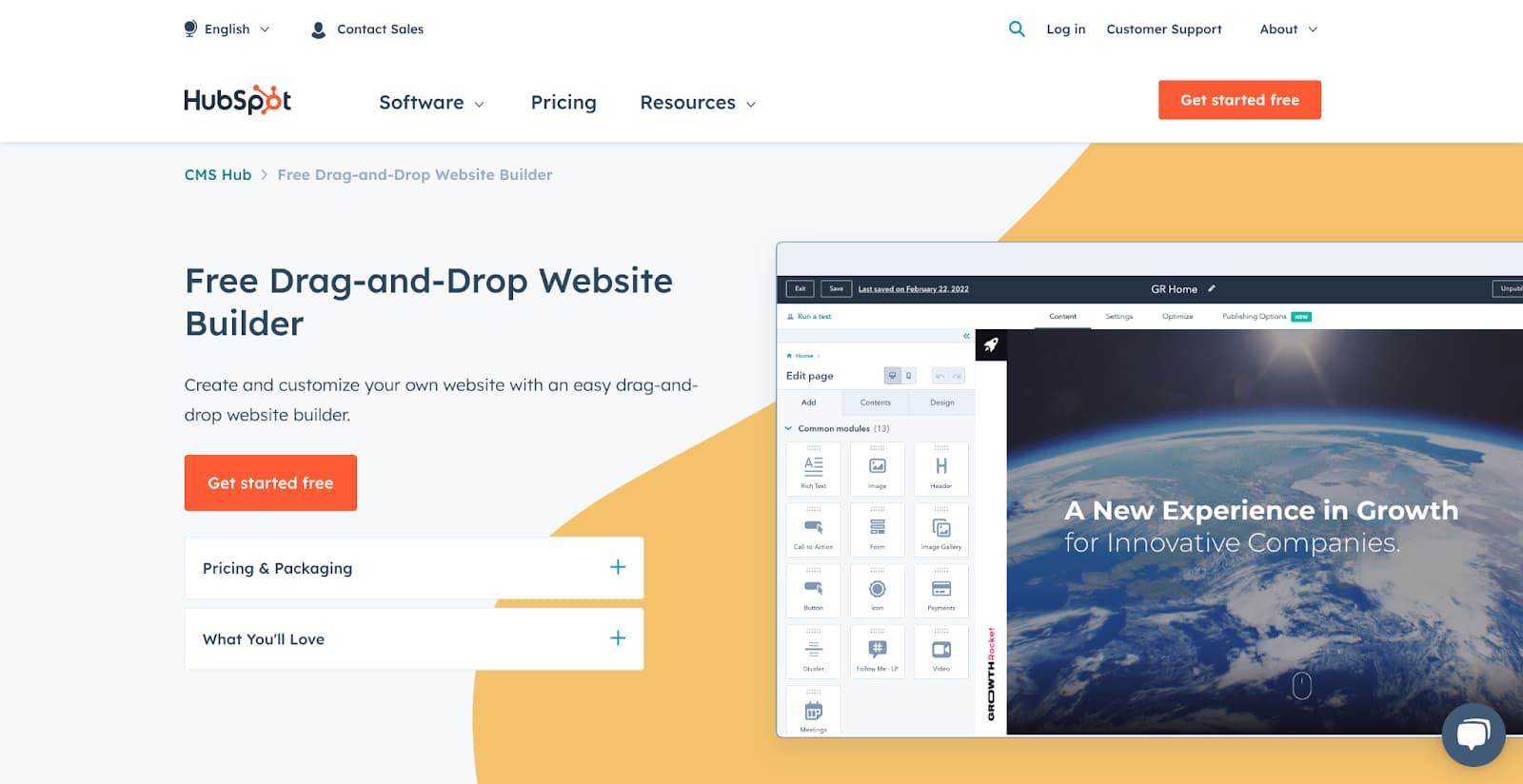 Designing a beautifully branded website doesn’t have to be complicated. If you’re taking the DIY-route to create your own website and don’t have coding experience, consider trying HubSpot’s drag-and-drop website builder.
Designing a beautifully branded website doesn’t have to be complicated. If you’re taking the DIY-route to create your own website and don’t have coding experience, consider trying HubSpot’s drag-and-drop website builder.
It comes with everything you need to build a website, including content management system (CMS) tools, themes and templates, security features, and a built-in content delivery network (CDN) to ensure pages load quickly.
It also connects easily with HubSpot CRM. That lets you integrate contact forms, live chat requests, and more, making it ideal for businesses already using HubSpot’s CRM tool.
Features:
Advantages:
- Personalization (thanks to HubSpot CRM)
- Security
- Responsive themes and templates
Disadvantages:
- Multi-language blog functionality is still being implemented
- No built-in e-commerce functionality
- You’ll need to learn HuBL (HubSpot’s templating language) to build custom modules and coded templates.
Pricing: Limited free plan available. The premium CMS plans with additional features start at $23/month when billed annually.
Brands using HubSpot:
2. Wix

With over 200 million users, Wix is one of the most popular free website builders. The easy-to-use, fully-hosted platform offers an easy drag-and-drop editor, an extensive collection of apps, and professional-looking templates. Wix can even propose a design for your site using its Artificial Design Intelligence (ADI) software, Editor X.
Features:
- Drag-and-drop editor
- Large collection of apps and templates
- Analytics and reporting
Advantages:
- Easy to use
- Large collection of apps and templates
- Optimized for mobile
Disadvantages:
- The free version displays ads.
- The premium plans are pricey when compared to others on this list.
- Unable to switch templates when the site goes live. The only way to change templates is by creating a new site and transferring your premium plan to it.
Pricing: Limited free plan available. Premium plans start at $16/month when billed annually.
Brands using Wix:
3. WordPress.com

WordPress is the world’s most popular free website builder, with a 43% market share in the content management space. When building websites with WordPress, you have two options: WordPress.org and WordPress.com.
WordPress.org lets you download WordPress’s open-source software so you can build and customize a website to fit your needs. However, there are a few caveats. Not only will you need a domain name and hosting before you get the website going (which comes at a cost), but you’ll also need to learn how to maintain and keep the website secure on your own.
In contrast, WordPress.com is much more beginner-friendly. It’s a fully-hosted free website building service offered by Automattic that uses the WordPress framework to provide a smooth website creation experience.
The only downside is that the free version is far less customizable than WordPress.org. For instance, you can’t customize plugins, and domain names are limited to [yourname].wordpress.com.
Still, WordPress.com’s free version empowers you to create visually stunning websites, blogs, and landing pages using the Classic Editor or the powerful new Gutenberg block-based editor. Below is an example of one of its pre-designed block-based templates:
Besides that, you can add assets like contact forms, videos, and embedded content to WordPress pages using plugins, an add-on feature compatible with WordPress but usually managed by another company.
For example, HubSpot offers a WordPress marketing plugin that lets you capture contacts through WordPress and track them in HubSpot’s free CRM.
Features:
- Large collection of themes and plugins
- Mobile-friendly and optimized for SEO
- Managed website hosting and security
Advantages:
- Customizable
- Flexible
- Mobile and desktop apps available
Disadvantages:
- The free version displays ads.
- More limitations compared to WordPress.org
- Although intuitive, it’s more difficult to learn than other drag-and-drop builders.
Pricing: Limited free plan available. Premium plans start at $16/month when billed annually.
Brands using WordPress.com:
4. Elementor Website Builder

While WordPress makes site building beginner-friendly, WordPress page builders make refining your website and achieving your dream design easier.
Trusted by over 5,000,000 users, Elementor is a no-code drag-and-drop page builder that’s a great option for getting a customized WordPress site off the ground quickly. Choose from hundreds of mobile-optimized page templates without worrying about the underlying code.
Features:
- Drag-and-drop builder
- Live editing
- Large library of mobile-responsive templates
- Multiple partners building templates and add-ons for Elementor (e.g., Astra)
Advantages:
- Beginner-friendly
- Live editing
- Third-party integrations
Disadvantages:
Pricing: Limited free plan available. Premium plans start at $49/year (without hosting).
Brands using Elementor:
5. Webnode

With over 40 million users, Webnode is one of the more popular website builder tools for a good reason. It’s affordable, easy to use, and supports multilingual websites — up to 20 different languages.
Webnode is perfect for personal, professional, and small business websites, as it supports e-commerce stores.
Features:
- Pre-designed templates
- Ecommerce support
- Mobile-ready
Advantages:
- Multilingual support
- Mobile-responsive pages
- Backup and restore features
Disadvantages:
- Webnode doesn’t come with a built-in app store, making it more complicated to add extra functionality to the website
- Limited customization options
- Limited blog and e-commerce functionality
Pricing:Limited free plan available. Premium plans start at $3.90/month when billed annually.
Brands using Webnode:
6. Jimdo
 Founded in 2007, Jimdo is a German-based company that provides AI-powered website builder tools for independent small businesses. The builder, Dolphin, asks users questions and suggests designs based on their answers. If you’re curious about what these AI-powered designs look like, Jimdo showcases a few examples on its page.
Founded in 2007, Jimdo is a German-based company that provides AI-powered website builder tools for independent small businesses. The builder, Dolphin, asks users questions and suggests designs based on their answers. If you’re curious about what these AI-powered designs look like, Jimdo showcases a few examples on its page.
With 500 MB of space, you’ll likely have more than enough space to build your site, and it even provides HTTPS/SSL encryption, meaning your visitor’s information will be kept safe. Plus, you can integrate your site seamlessly with social media accounts.
Jimdo is also an excellent option for international companies because it lets you create mobile-optimized websites in over nine languages.
Features:
- AI-powered website builder
- SSL encryption
- GDPR-compliant
- Mobile app available
Advantages:
- Easy to use
- Mobile-responsive
- Fast load speeds
Disadvantages:
- Limited range of available features
- Few design options
Pricing: Limited free plan available. Premium plans start at $9/month when billed annually.
Brands using Jimdo:
7. Mozello

Mozello has all the basic features you need to build a website: a drag-and-drop editor, template library, and even supports ecommerce functionality. One of the biggest selling points for Mozello is that the builder allows you to create a multilingual site for free.
You can check samples of websites built on Mozello on its portfolio page.
Features:
- Drag-and-drop website builder
- Template library
Advantages:
- Easy to use
- Support for multilingual websites
- Ecommerce functionality
Disadvantages:
- The drag-and-drop builder isn’t as intuitive as some others on this list.
- Limited design customization
- The free version displays ads
Pricing: Limited free plan available. Premium plans start at $8/month when billed annually.
Brands using Mozello:
8. Yola
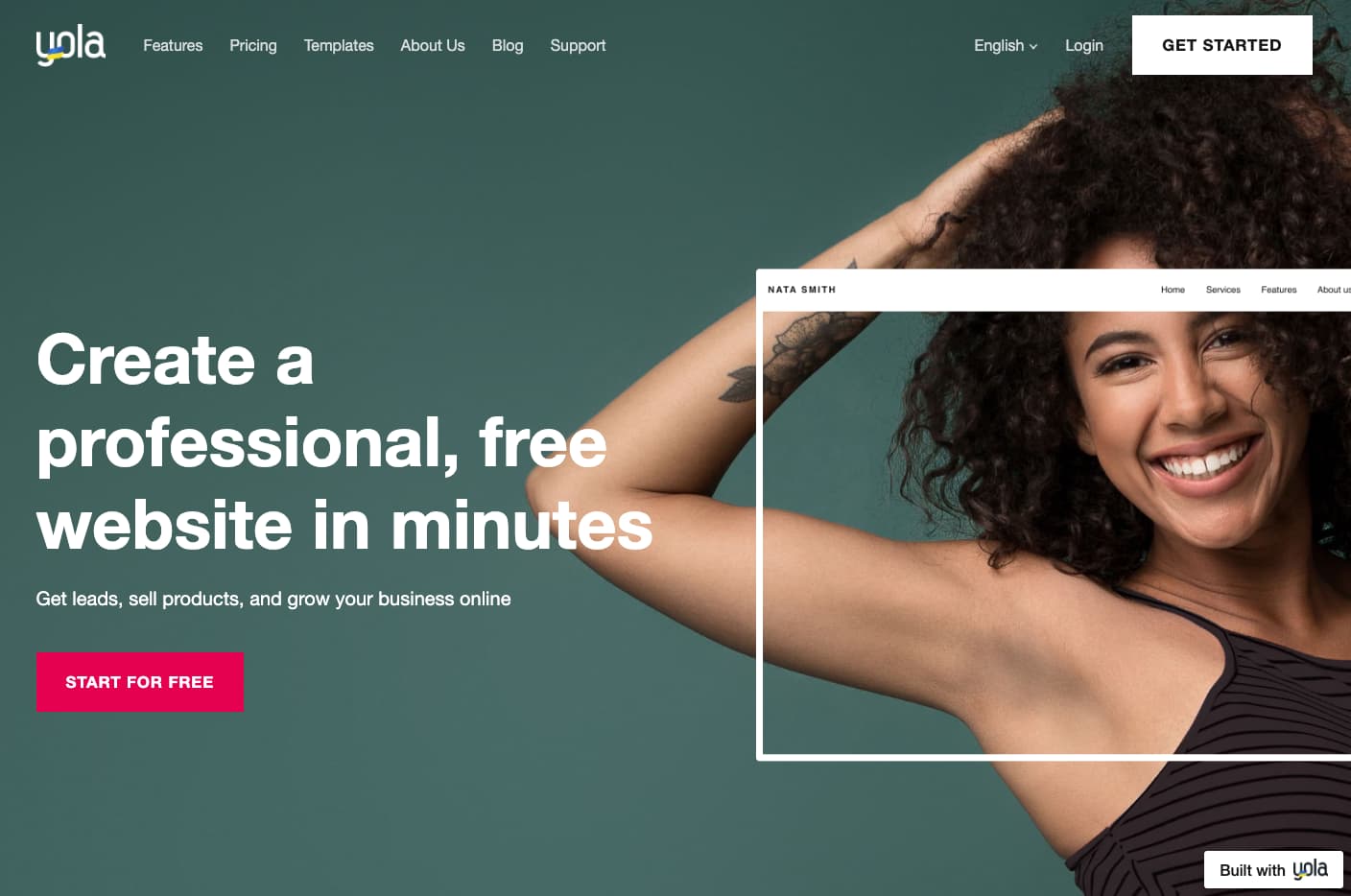
Founded in 2007, Yola is a free website builder built to eliminate the hassle of creating a website.
It comes with a drag-and-drop builder, hundreds of customizable and mobile-optimized templates, and pre-designed blocks that allow you to create all kinds of websites — even online shops.
Features:
- Drag-and-drop website builder
- Free customizable templates
- Support for multilingual websites
Advantages:
- Ecommerce features available
- Social selling features
- Mobile-optimized
Disadvantages:
- No blogging feature
- The free version displays ads
- Navigation and design limitations
Pricing: Limited free plan available. Premium plans start at $4/month when billed annually.
Brands using Yola:
9. Weebly

Weebly is an open-source software-as-a-service (SaaS) that offers web hosting, domain registration, web design, and e-commerce functions, making it suitable for businesses and startups. For a free website builder, Weebly’s particularly flexible — it’s compatible with every device and platform and easy to use.
Like Wix, Weebly has drag-and-drop functionality, an integrated CMS solution, and hand-coded HTML files. The in-house editor comes with SEO tools and Google Analytics.
Features:
- Drag-and-drop editor
- Integrated CMS solution
- Free SSL certificate
- SEO tools
- Analytics and reporting
Advantages:
- Helpful SEO resource tools
- Good selection of paid and free apps in the app center
- The free plan has e-commerce functionality
Disadvantages:
Pricing: Limited free plan available. Premium plans start at $6/month when billed annually.
Brands using Weebly:
10. Webflow

While most of the other builders in this list are for people without a ton of coding knowledge, Webflow specifically targets advanced users, designers, and agencies that require a solution that gives them more design freedom than traditional website builder tools.
Although it’s a complex tool, Webflow tries to make it as easy as possible to get your business online. Webflow has a robust set of resources to help you — blog posts, forums, FAQ sections, and a library of websites built on Webflow that you can check for reference.
Features:
- Drag-and-drop website builder
- Widgets to add features like maps and media
- Third-party integrations
Advantages:
- Offers complete control over your site’s design
- Drag-and-drop what-you-see-is-what-you-get (WYSIWYG) builder
- Responsive interface
Disadvantages:
- Purely a website builder. After building a website on Webflow, you need to transfer it to a content management system.
- Requires some knowledge of HTML and CSS to access full features
- It has a complex free and paid plan structure. You need to sign up for both a Site and Workspace plan.
Pricing: Limited free plan available. Premium plans start at $12/month when billed annually.
Brands using Webflow:
11. Ucraft
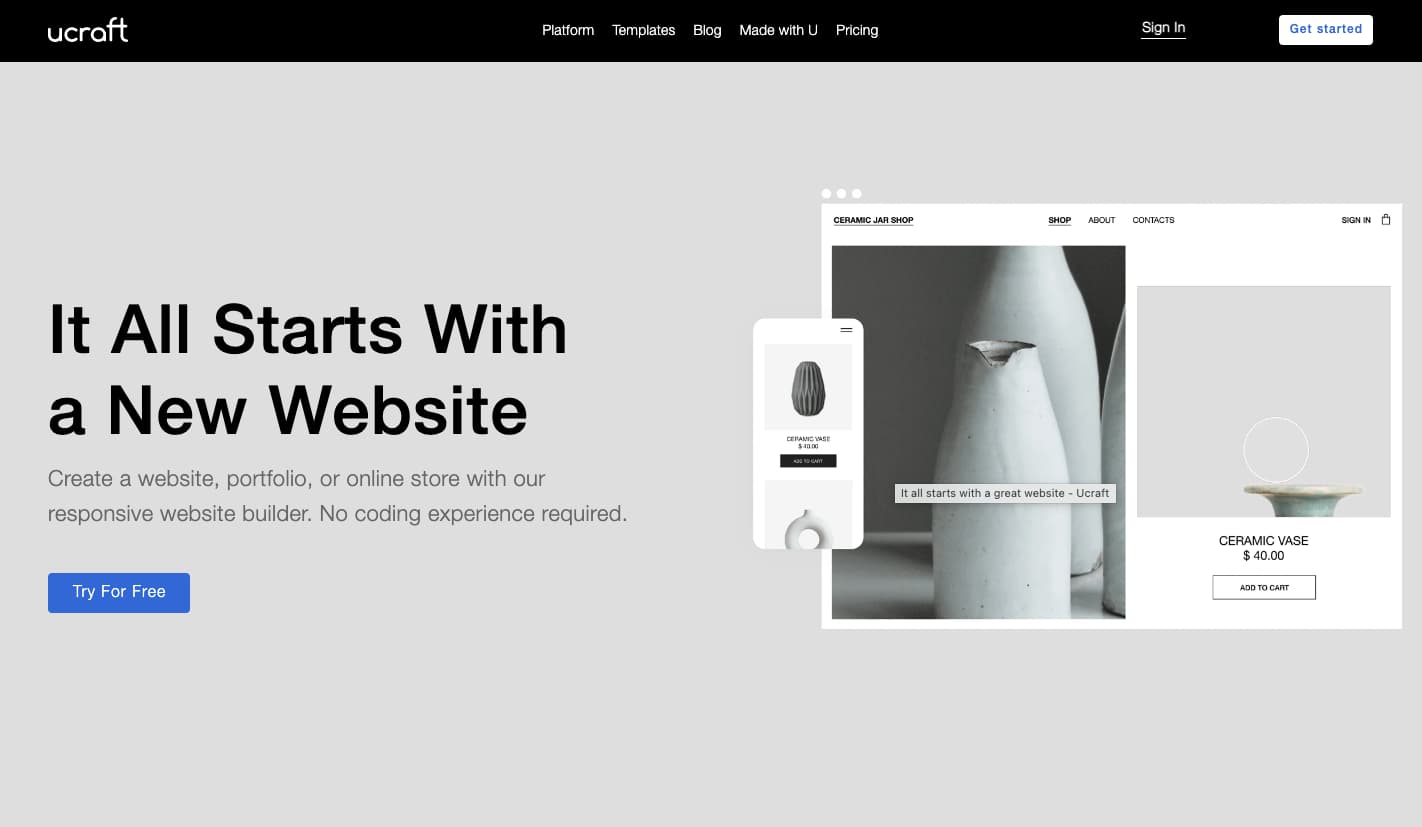
Ucraft is one of the more advanced and generous website builders on the list. Like the others, it’s got a drag-and-drop editor, a good selection of templates, and supports e-commerce functionality.
However, Ucraft stands out because it lets you connect an existing custom domain name with its free plan. It also comes with an SSL certificate and unlimited storage. Ucraft’s portfolio page shows sample websites built by its clients.
Features:
- Drag-and-drop editor
- Free hosting
- Ecommerce functionality
Advantages:
- Allows you to connect an existing domain name for free
- Decent selection of free templates
- Includes SSL and unlimited storage on free plans
Disadvantages:
- Sporadic loading issues and bugs.
- It has a steeper learning curve than most website builders on this list.
Pricing: Limited free plan available. Premium plans start at $10/month when billed annually.
Brands using Ucraft:
12. SITE123
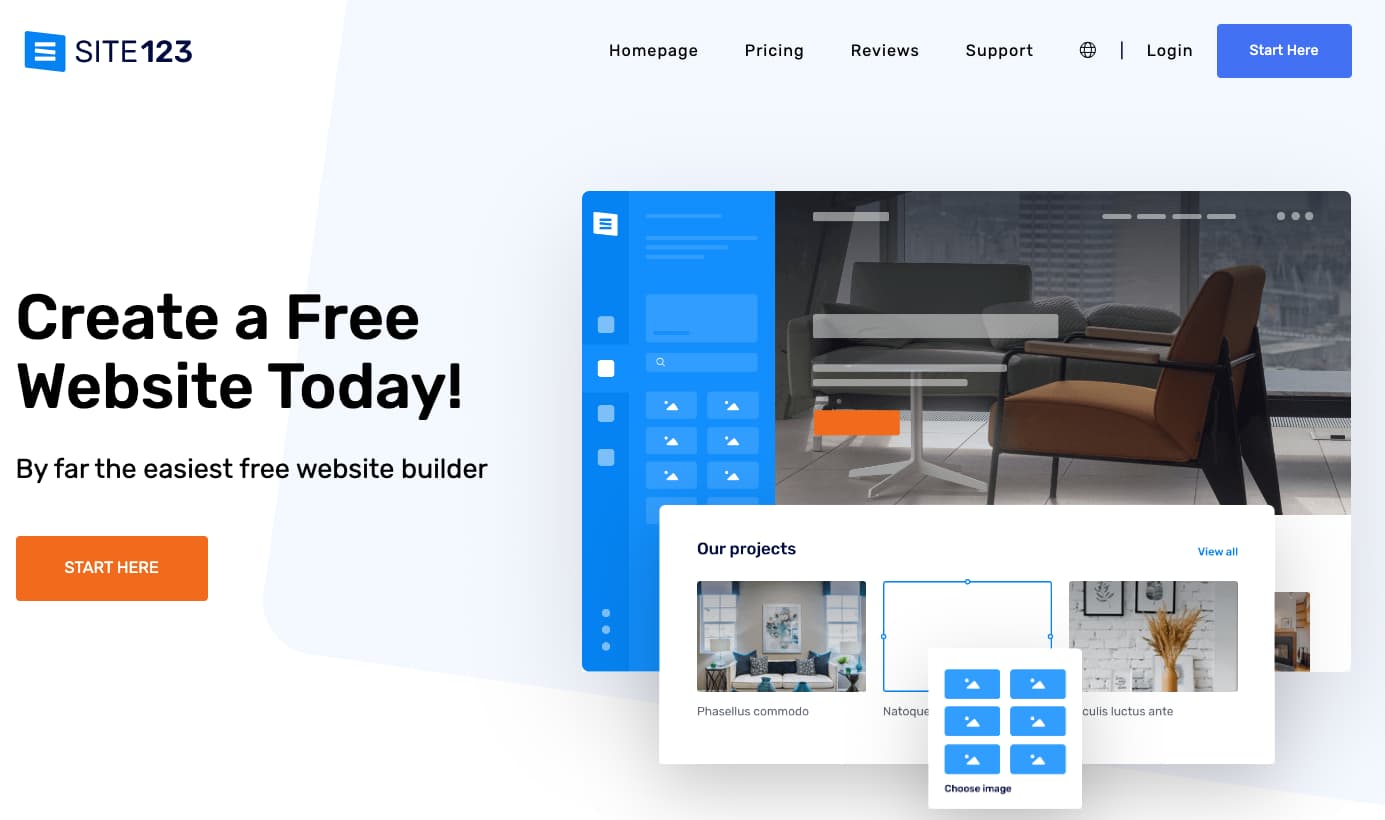
True to its name, SITE123 lets you build a website in as easy as one, two, and three steps. After setting it up with a one-click installation wizard, you can customize your SITE123 website with a free library of images, graphics, and templates.
Moreover, SITE123 offers web hosting, domain registration, and 250 MB of storage space, so you won’t feel pressured to switch to a paid plan.
Features:
- Free hosting and domain
- Mobile-responsive design
- Free image and icons library
Advantages:
- Easy to use
- Multilingual support
- 24/7 tech support
Disadvantages:
- No drag-and-drop function
- Limited storage on the free plan
- Lacks advanced customization features
Pricing: Limited free plan available. Premium plans start at $5.80/month when billed annually.
Brands using SITE123:
13. Strikingly
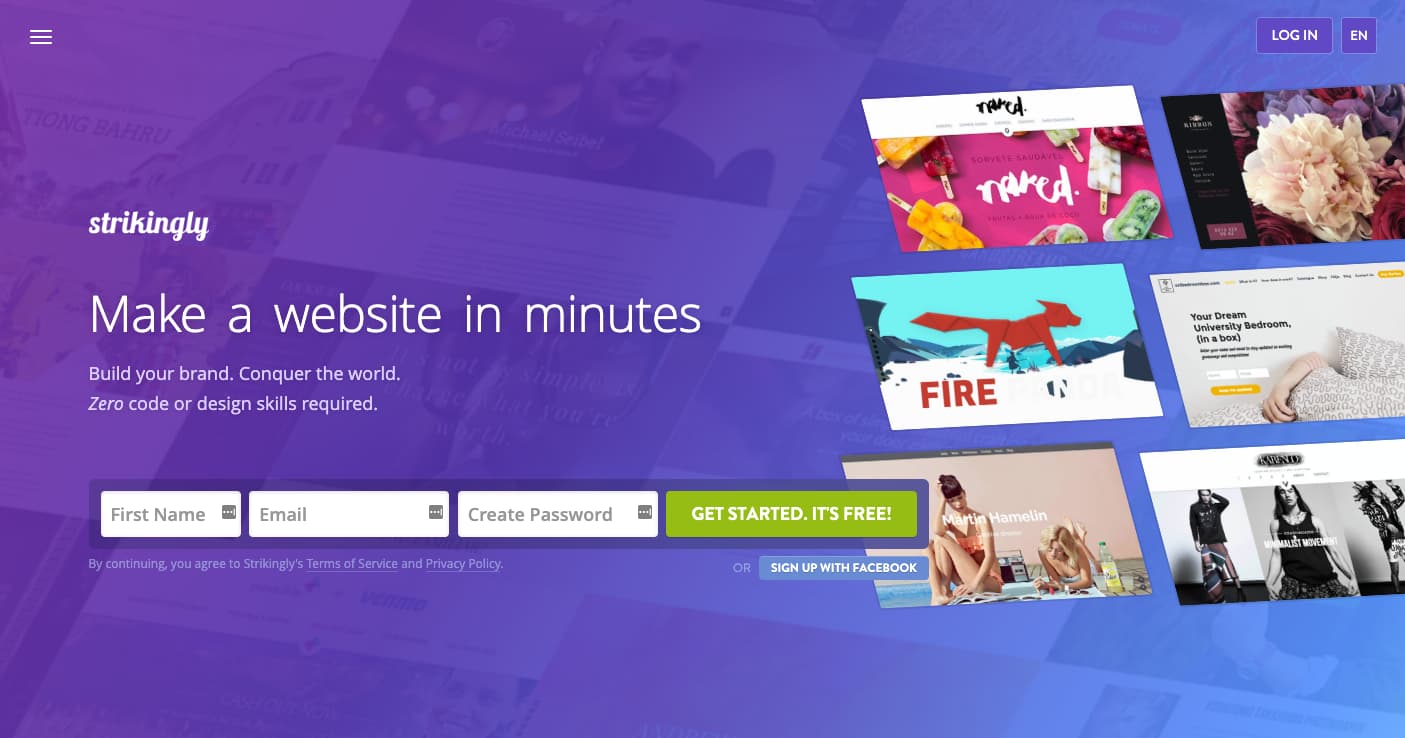
Launched in 2012, Strikingly is one of the newer website builder tools on the list. It helps users build websites with no programming skills required and sets itself apart from competitors by specializing in single-page websites such as portfolios, event pages, or landing pages.
The free plan includes unlimited free sites, a modest 5 GB monthly bandwidth, 500MB storage, and a branded domain.
Features:
- Library of mobile-optimized templates
- Ecommerce tools
- Analytics
Advantages:
- An affordable option for those who want to create multiple sites
- Best for creating single-page websites
- Responsive support team
Disadvantages:
- No drag-and-drop function
- Limited SEO functionality
Pricing: Limited free plan available. Premium plans start at $8/month when billed annually.
Brands using Strikingly:
14. GoDaddy
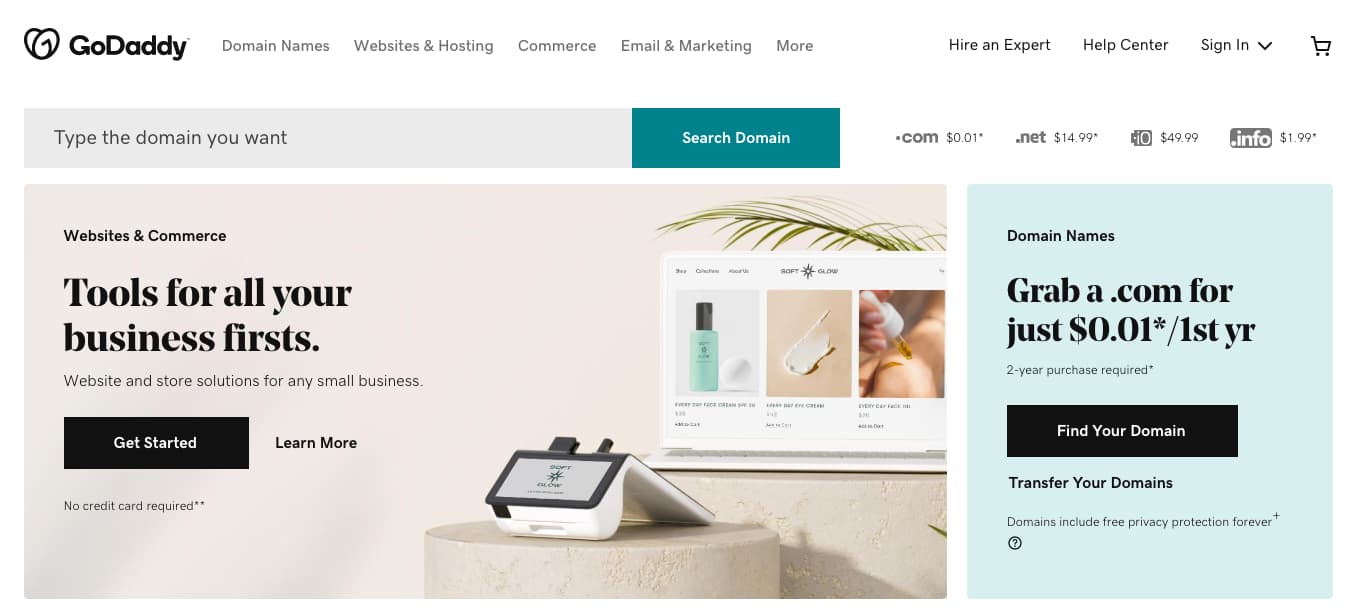
While GoDaddy is a brand synonymous with affordable web hosting and domains, it’s expanded its offerings to include an all-in-one website builder tool for beginners and small business owners that have purchased hosting and domains.
The website builder is basic, but it has everything you need to build a functional website, including a drag-and-drop editor, simple and clean templates, an SSL certificate, and social media tools.
Features:
- Drag-and-drop website builder
- Marketing and analytics dashboard
- 24/7 customer support
Advantages:
- All-in-one solution
- Easy to use
- Mobile-optimized
- Fast page load speeds
Disadvantages:
- Limited SEO features
- Limited app store features
- Having your own web hosting and domain carries an initial cost
Pricing: Limited free plan — upgrade features at your own pace. Premium plans start at $9.99/month when billed annually.
Brands using GoDaddy:
15. Appy Pie Website

Appy Pie’s website builder has a drag-and-drop interface that allows you to create well-designed, highly functional, and professional websites without any coding skills or programming knowledge. With Appy Pie’s Website Builder, you can create many websites for any purpose, including social media, salons, or real estate.
All the websites created using Appy Pie website builder are lightweight, fast, and secure to ensure a better user experience and complete customer satisfaction. And since they consume low data, all Appy Pie websites can deliver content without any internet connectivity.
Appy Pie has a ton of ready-to-use templates, design themes, and a visual library to make it easy for users to develop websites at competitive prices. In addition, the Appy Pie Website Builder also provides a rich library of frequently asked questions and video tutorials so that you can easily tackle most of the issues without them having to call customer support.
Features:
- No code website development tool
- Thousands of pre-built templates and designs
- Cross-platform accessibility
Advantages:
- Scalability
- Reusability
- Integrability
Disadvantages:
- No advanced settings for pro users
- Dependence on external services
- Closed development code
Pricing: Limited free plan. Premium plans start at $18/month
Brands using Appy Pie Website:
Website Builder Features You Need
Choosing a website builder tool is easier when you know what you’re looking for. Here are 14 features to look out for:
1. Themes and Templates
Having an assortment of fully customizable website themes and templates on the website builder’s theme marketplaces makes it easier for users to change their site’s look.
In that sense, website builders should have theme options that cater to specific niches so users don’t waste time creating new templates from scratch. For example, the website builders on our list have options for blogs, portfolio websites, e-commerce websites, and more.
Templates should be pre-structured and pre-populated with images, text, and other elements commonly found on pages like the Homepage, About page, or Contact page. All you need to do is pick one and replace the sample content with your own.
Themes and templates should be easy to customize — with multiple options for backgrounds, layouts, fonts, and colors.
2. Media (Video, Photo, Audio, Graphics)
Solely having text on your website can be monotonous, so including different forms of media helps break up text and can help information stick because not everyone learns the same way. A website with no visual content is like walking into a vacant restaurant. Fill out your website with highly engaging multimedia content and graphics to support vital information, engage users and drive traffic.
You can easily bring your website to life using visual aids and mediums like stock photos, vector images, background images, stock video footage, sound effects, and video editing templates. There are tons of websites that provide media resources that are free to use for content. Freepik is a well-known website that provides illustrations and images. Many sites also incorporate icons into their sites like within the call-to-actions and resources sections. Flaticon is a great source of icons. Using these resources will transform your website into something memorable and visually appealing while also providing a user-friendly experience.
Some website builders offer more robust media capabilities, with multiple gallery layouts, customization options, and editing features.
3. WYSIWYG Editor
Besides an assortment of themes and templates, the best website builder tools make it easy for users to customize their websites with drag-and-drop tools and what you see is what you get (WYSIWYG) editors.
There’s no need to learn how to code when you can update your site in a few clicks. Simply drag-and-drop elements to the page and see the changes implemented to your website immediately.
4. Malware Scanning
Security is a top consideration when choosing a website builder.
Security features vary depending on the website builder tool you select, but consider it a keeper if it offers malware scanning. Automated malware scanning allows you to address threats before it progresses into something catastrophic proactively.
5. Web Application Firewall (WAF)
A web application firewall (WAF) is another must-have security feature.
It often sits between your web server and the internet to protect your website from common attacks like SQL injections and cross-site scripting (XSS) by filtering, monitoring, and blocking malicious traffic from entering the network.
WAFs can come in the form of software-as-a-service (SaaS), and you can customize them to meet your website’s unique needs.
6. Content Delivery Network (CDN)
Besides site security, you should also consider optimizing for page speed. After all, it affects everything from customer experience to conversions and revenue.
According to Portent, a site that loads in one second has a conversion rate 5x higher than a site that loads in 10 seconds.
There are many ways to improve page speed, and a content delivery network (CDN) is one way to do it. CDNs store heavy and static content on distributed servers located worldwide and load the cached content from a location nearest to the user to speed up its delivery.
7. Web Hosting
What good are website builders when they can’t get your website online?
Some solutions only offer website builder tools to build your site — you have to pay separately for web hosting services to get your site online.
The best website builders make it convenient to start websites by offering web hosting. Free website builders offer limited bandwidth and storage — just for personal use. You can upgrade to shared, dedicated, or managed hosting for an additional fee.
8. Storage
Web hosting works by providing two services: bandwidth and disk space (or storage).
Most free website builders offer ample (limited) storage for a beginner site but require you to purchase additional storage should you need it.
9. Blogs
People often confuse websites and blogs with each other — they’re similar but not the same.
A blog is a type of website that contains information about different topics. They’re often updated with new articles or posts, while websites only receive updates when needed. In a nutshell, all blogs are websites, but not all websites are or have blogs.
Organizations build websites for different reasons: to sell, showcase a portfolio, or inform — and for those reasons, a blog can be helpful.
Blogs can help your website by:
- Increasing visibility through SEO
- Generating new leads
- Building trust and loyalty
- Creating brand awareness
Most free website builders come with basic blogging tools and post creation and comment management features.
10. SEO Capabilities
According to BrightEdge, 53% of traffic comes from organic search.
If you want to bring in more traffic and views, your website needs to be search engine-optimized.
Most website builders help with technical SEO by offering free SSL certificates and supporting schema markup and XML sitemaps. They also support on-page SEO by allowing you to enter and modify URLs, meta tags, and image alt attributes.
11. Customer Support
While using website builder tools, you’ll likely run into a problem you can’t troubleshoot. That is where customer support comes in.
Customer support assists you with anything you need help with — technical, sales, billing, payments, or experiences. Depending on the website builder, assistance can come in any (or a mix) of the following channels:
The best website builders keep a mix of channels and answer inquiries promptly.
12. E-commerce Capabilities
Are you planning on selling physical or digital products in the future? Consider choosing a website builder tool with e-commerce capabilities.
There are dedicated e-commerce website builders, but these are often paid solutions with robust functionality such as apps for payment and shipping.
Free website builders often integrate with a third-party e-commerce application or support a simple built-in store.
13. Third-party Integrations
There’s nothing worse than realizing your existing tech stack doesn’t work with the website builder you chose. Thus, it’s crucial to consider whether a website builder allows third-party integrations.
Your website builder should integrate with external tools, such as email marketing, e-commerce, and social software.
14. Analytics and Reporting
Your website builder should also have an analytics and reporting function to measure important metrics like the site’s popular pages, bounce rate, average duration per visit, and more.
Alternatively, you can track your website metrics in an analytics and reporting tool. When you bring your web analytics together with other key funnel metrics like trials or activation rate onto a dashboard, you give everyone on your team the ability to explore your data and uncover insights.
Picking Your Website Builder
There you have it! Since most of these website builders are free, try out a couple if you’re unsure of the best fit. In particular, take note of what you really want to get out of your site to ensure your needs will be met by one of these builders.
Editor’s Note: This post was originally published in November 2018 but was updated in October 2019 for comprehensiveness.
MARKETING
Ecommerce evolution: Blurring the lines between B2B and B2C

Understanding convergence
B2B and B2C ecommerce are two distinct models of online selling. B2B ecommerce is between businesses, such as wholesalers, distributors, and manufacturers. B2C ecommerce refers to transactions between businesses like retailers and consumer brands, directly to individual shoppers.
However, in recent years, the boundaries between these two models have started to fade. This is known as the convergence between B2B and B2C ecommerce and how they are becoming more similar and integrated.
Source: White Paper: The evolution of the B2B Consumer Buyer (ClientPoint, Jan 2024)
What’s driving this change?
Ever increasing customer expectations
Customers today expect the same level of convenience, speed, and personalization in their B2B transactions as they do in their B2C interactions. B2B buyers are increasingly influenced by their B2C experiences. They want research, compare, and purchase products online, seamlessly transitioning between devices and channels. They also prefer to research and purchase online, using multiple devices and channels.
Forrester, 68% of buyers prefer to research on their own, online . Customers today expect the same level of convenience, speed, and personalization in their B2B transactions as they do in their B2C interactions. B2B buyers are increasingly influenced by their B2C experiences. They want research, compare, and purchase products online, seamlessly transitioning between devices and channels. They also prefer to research and purchase online, using multiple devices and channels
Technology and omnichannel strategies
Technology enables B2B and B2C ecommerce platforms to offer more features and functionalities, such as mobile optimization, chatbots, AI, and augmented reality. Omnichannel strategies allow B2B and B2C ecommerce businesses to provide a seamless and consistent customer experience across different touchpoints, such as websites, social media, email, and physical stores.
However, with every great leap forward comes its own set of challenges. The convergence of B2B and B2C markets means increased competition. Businesses now not only have to compete with their traditional rivals, but also with new entrants and disruptors from different sectors. For example, Amazon Business, a B2B ecommerce platform, has become a major threat to many B2B ecommerce businesses, as it offers a wide range of products, low prices, and fast delivery
“Amazon Business has proven that B2B ecommerce can leverage popular B2C-like functionality” argues Joe Albrecht, CEO / Managing Partner, Xngage. . With features like Subscribe-and-Save (auto-replenishment), one-click buying, and curated assortments by job role or work location, they make it easy for B2B buyers to go to their website and never leave. Plus, with exceptional customer service and promotional incentives like Amazon Business Prime Days, they have created a reinforcing loyalty loop.
And yet, according to Barron’s, Amazon Business is only expected to capture 1.5% of the $5.7 Trillion addressable business market by 2025. If other B2B companies can truly become digital-first organizations, they can compete and win in this fragmented space, too.”
If other B2B companies can truly become digital-first organizations, they can also compete and win in this fragmented space
Joe AlbrechtCEO/Managing Partner, XNGAGE
Increasing complexity
Another challenge is the increased complexity and cost of managing a converging ecommerce business. Businesses have to deal with different customer segments, requirements, and expectations, which may require different strategies, processes, and systems. For instance, B2B ecommerce businesses may have to handle more complex transactions, such as bulk orders, contract negotiations, and invoicing, while B2C ecommerce businesses may have to handle more customer service, returns, and loyalty programs. Moreover, B2B and B2C ecommerce businesses must invest in technology and infrastructure to support their convergence efforts, which may increase their operational and maintenance costs.
How to win
Here are a few ways companies can get ahead of the game:
Adopt B2C-like features in B2B platforms
User-friendly design, easy navigation, product reviews, personalization, recommendations, and ratings can help B2B ecommerce businesses to attract and retain more customers, as well as to increase their conversion and retention rates.
According to McKinsey, ecommerce businesses that offer B2C-like features like personalization can increase their revenues by 15% and reduce their costs by 20%. You can do this through personalization of your website with tools like Product Recommendations that help suggest related products to increase sales.
Focus on personalization and customer experience
B2B and B2C ecommerce businesses need to understand their customers’ needs, preferences, and behaviors, and tailor their offerings and interactions accordingly. Personalization and customer experience can help B2B and B2C ecommerce businesses to increase customer satisfaction, loyalty, and advocacy, as well as to improve their brand reputation and competitive advantage. According to a Salesforce report, 88% of customers say that the experience a company provides is as important as its products or services.
Market based on customer insights
Data and analytics can help B2B and B2C ecommerce businesses to gain insights into their customers, markets, competitors, and performance, and to optimize their strategies and operations accordingly. Data and analytics can also help B2B and B2C ecommerce businesses to identify new opportunities, trends, and innovations, and to anticipate and respond to customer needs and expectations. According to McKinsey, data-driven organizations are 23 times more likely to acquire customers, six times more likely to retain customers, and 19 times more likely to be profitable.
What’s next?
The convergence of B2B and B2C ecommerce is not a temporary phenomenon, but a long-term trend that will continue to shape the future of ecommerce. According to Statista, the global B2B ecommerce market is expected to reach $20.9 trillion by 2027, surpassing the B2C ecommerce market, which is expected to reach $10.5 trillion by 2027. Moreover, the report predicts that the convergence of B2B and B2C ecommerce will create new business models, such as B2B2C, B2A (business to anyone), and C2B (consumer to business).
Therefore, B2B and B2C ecommerce businesses need to prepare for the converging ecommerce landscape and take advantage of the opportunities and challenges it presents. Here are some recommendations for B2B and B2C ecommerce businesses to navigate the converging landscape:
- Conduct a thorough analysis of your customers, competitors, and market, and identify the gaps and opportunities for convergence.
- Develop a clear vision and strategy for convergence, and align your goals, objectives, and metrics with it.
- Invest in technology and infrastructure that can support your convergence efforts, such as cloud, mobile, AI, and omnichannel platforms.
- Implement B2C-like features in your B2B platforms, and vice versa, to enhance your customer experience and satisfaction.
- Personalize your offerings and interactions with your customers, and provide them with relevant and valuable content and solutions.
- Leverage data and analytics to optimize your performance and decision making, and to innovate and differentiate your business.
- Collaborate and partner with other B2B and B2C ecommerce businesses, as well as with other stakeholders, such as suppliers, distributors, and customers, to create value and synergy.
- Monitor and evaluate your convergence efforts, and adapt and improve them as needed.
By following these recommendations, B2B and B2C ecommerce businesses can bridge the gap between their models and create a more integrated and seamless ecommerce experience for their customers and themselves.
MARKETING
Streamlining Processes for Increased Efficiency and Results

How can businesses succeed nowadays when technology rules? With competition getting tougher and customers changing their preferences often, it’s a challenge. But using marketing automation can help make things easier and get better results. And in the future, it’s going to be even more important for all kinds of businesses.
So, let’s discuss how businesses can leverage marketing automation to stay ahead and thrive.
Benefits of automation marketing automation to boost your efforts
First, let’s explore the benefits of marketing automation to supercharge your efforts:
Marketing automation simplifies repetitive tasks, saving time and effort.
With automated workflows, processes become more efficient, leading to better productivity. For instance, automation not only streamlines tasks like email campaigns but also optimizes website speed, ensuring a seamless user experience. A faster website not only enhances customer satisfaction but also positively impacts search engine rankings, driving more organic traffic and ultimately boosting conversions.
Automation allows for precise targeting, reaching the right audience with personalized messages.
With automated workflows, processes become more efficient, leading to better productivity. A great example of automated workflow is Pipedrive & WhatsApp Integration in which an automated welcome message pops up on their WhatsApp
within seconds once a potential customer expresses interest in your business.
Increases ROI
By optimizing campaigns and reducing manual labor, automation can significantly improve return on investment.
Leveraging automation enables businesses to scale their marketing efforts effectively, driving growth and success. Additionally, incorporating lead scoring into automated marketing processes can streamline the identification of high-potential prospects, further optimizing resource allocation and maximizing conversion rates.
Harnessing the power of marketing automation can revolutionize your marketing strategy, leading to increased efficiency, higher returns, and sustainable growth in today’s competitive market. So, why wait? Start automating your marketing efforts today and propel your business to new heights, moreover if you have just learned ways on how to create an online business
How marketing automation can simplify operations and increase efficiency
Understanding the Change
Marketing automation has evolved significantly over time, from basic email marketing campaigns to sophisticated platforms that can manage entire marketing strategies. This progress has been fueled by advances in technology, particularly artificial intelligence (AI) and machine learning, making automation smarter and more adaptable.
One of the main reasons for this shift is the vast amount of data available to marketers today. From understanding customer demographics to analyzing behavior, the sheer volume of data is staggering. Marketing automation platforms use this data to create highly personalized and targeted campaigns, allowing businesses to connect with their audience on a deeper level.
The Emergence of AI-Powered Automation
In the future, AI-powered automation will play an even bigger role in marketing strategies. AI algorithms can analyze huge amounts of data in real-time, helping marketers identify trends, predict consumer behavior, and optimize campaigns as they go. This agility and responsiveness are crucial in today’s fast-moving digital world, where opportunities come and go in the blink of an eye. For example, we’re witnessing the rise of AI-based tools from AI website builders, to AI logo generators and even more, showing that we’re competing with time and efficiency.
Combining AI-powered automation with WordPress management services streamlines marketing efforts, enabling quick adaptation to changing trends and efficient management of online presence.
Moreover, AI can take care of routine tasks like content creation, scheduling, and testing, giving marketers more time to focus on strategic activities. By automating these repetitive tasks, businesses can work more efficiently, leading to better outcomes. AI can create social media ads tailored to specific demographics and preferences, ensuring that the content resonates with the target audience. With the help of an AI ad maker tool, businesses can efficiently produce high-quality advertisements that drive engagement and conversions across various social media platforms.
Personalization on a Large Scale
Personalization has always been important in marketing, and automation is making it possible on a larger scale. By using AI and machine learning, marketers can create tailored experiences for each customer based on their preferences, behaviors, and past interactions with the brand.
This level of personalization not only boosts customer satisfaction but also increases engagement and loyalty. When consumers feel understood and valued, they are more likely to become loyal customers and brand advocates. As automation technology continues to evolve, we can expect personalization to become even more advanced, enabling businesses to forge deeper connections with their audience. As your company has tiny homes for sale California, personalized experiences will ensure each customer finds their perfect fit, fostering lasting connections.
Integration Across Channels
Another trend shaping the future of marketing automation is the integration of multiple channels into a cohesive strategy. Today’s consumers interact with brands across various touchpoints, from social media and email to websites and mobile apps. Marketing automation platforms that can seamlessly integrate these channels and deliver consistent messaging will have a competitive edge. When creating a comparison website it’s important to ensure that the platform effectively aggregates data from diverse sources and presents it in a user-friendly manner, empowering consumers to make informed decisions.
Omni-channel integration not only betters the customer experience but also provides marketers with a comprehensive view of the customer journey. By tracking interactions across channels, businesses can gain valuable insights into how consumers engage with their brand, allowing them to refine their marketing strategies for maximum impact. Lastly, integrating SEO services into omni-channel strategies boosts visibility and helps businesses better understand and engage with their customers across different platforms.
The Human Element
While automation offers many benefits, it’s crucial not to overlook the human aspect of marketing. Despite advances in AI and machine learning, there are still elements of marketing that require human creativity, empathy, and strategic thinking.
Successful marketing automation strikes a balance between technology and human expertise. By using automation to handle routine tasks and data analysis, marketers can focus on what they do best – storytelling, building relationships, and driving innovation.
Conclusion
The future of marketing automation looks promising, offering improved efficiency and results for businesses of all sizes.
As AI continues to advance and consumer expectations change, automation will play an increasingly vital role in keeping businesses competitive.
By embracing automation technologies, marketers can simplify processes, deliver more personalized experiences, and ultimately, achieve their business goals more effectively than ever before.
MARKETING
Will Google Buy HubSpot? | Content Marketing Institute

Google + HubSpot. Is it a thing?
This week, a flurry of news came down about Google’s consideration of purchasing HubSpot.
The prospect dismayed some. It delighted others.
But is it likely? Is it even possible? What would it mean for marketers? What does the consideration even mean for marketers?
Well, we asked CMI’s chief strategy advisor, Robert Rose, for his take. Watch this video or read on:
Why Alphabet may want HubSpot
Alphabet, the parent company of Google, apparently is contemplating the acquisition of inbound marketing giant HubSpot.
The potential price could be in the range of $30 billion to $40 billion. That would make Alphabet’s largest acquisition by far. The current deal holding that title happened in 2011 when it acquired Motorola Mobility for more than $12 billion. It later sold it to Lenovo for less than $3 billion.
If the HubSpot deal happens, it would not be in character with what the classic evil villain has been doing for the past 20 years.
At first glance, you might think the deal would make no sense. Why would Google want to spend three times as much as it’s ever spent to get into the inbound marketing — the CRM and marketing automation business?
At a second glance, it makes a ton of sense.
I don’t know if you’ve noticed, but I and others at CMI spend a lot of time discussing privacy, owned media, and the deprecation of the third-party cookie. I just talked about it two weeks ago. It’s really happening.
All that oxygen being sucked out of the ad tech space presents a compelling case that Alphabet should diversify from third-party data and classic surveillance-based marketing.
Yes, this potential acquisition is about data. HubSpot would give Alphabet the keys to the kingdom of 205,000 business customers — and their customers’ data that almost certainly numbers in the tens of millions. Alphabet would also gain access to the content, marketing, and sales information those customers consumed.
Conversely, the deal would provide an immediate tip of the spear for HubSpot clients to create more targeted programs in the Alphabet ecosystem and upload their data to drive even more personalized experiences on their own properties and connect them to the Google Workspace infrastructure.
When you add in the idea of Gemini, you can start to see how Google might monetize its generative AI tool beyond figuring out how to use it on ads on search results pages.
What acquisition could mean for HubSpot customers
I may be stretching here but imagine this world. As a Hubspoogle customer, you can access an interface that prioritizes your owned media data (e.g., your website, your e-commerce catalog, blog) when Google’s Gemini answers a question).
Recent reports also say Google may put up a paywall around the new premium features of its artificial intelligence-powered Search Generative Experience. Imagine this as the new gating for marketing. In other words, users can subscribe to Google’s AI for free, but Hubspoogle customers can access that data and use it to create targeted offers.
The acquisition of HubSpot would immediately make Google Workspace a more robust competitor to Microsoft 365 Office for small- and medium-sized businesses as they would receive the ADDED capability of inbound marketing.
But in the world of rented land where Google is the landlord, the government will take notice of the acquisition. But — and it’s a big but, I cannot lie (yes, I just did that). The big but is whether this acquisition dance can happen without going afoul of regulatory issues.
Some analysts say it should be no problem. Others say, “Yeah, it wouldn’t go.” Either way, would anybody touch it in an election year? That’s a whole other story.
What marketers should realize
So, what’s my takeaway?
It’s a remote chance that Google will jump on this hard, but stranger things have happened. It would be an exciting disruption in the market.
The sure bet is this. The acquisition conversation — as if you needed more data points — says getting good at owned media to attract and build audiences and using that first-party data to provide better communication and collaboration with your customers are a must.
It’s just a matter of time until Google makes a move. They might just be testing the waters now, but they will move here. But no matter what they do, if you have your customer data house in order, you’ll be primed for success.
HANDPICKED RELATED CONTENT:
Cover image by Joseph Kalinowski/Content Marketing Institute
-

 MARKETING7 days ago
MARKETING7 days agoRoundel Media Studio: What to Expect From Target’s New Self-Service Platform
-

 SEO6 days ago
SEO6 days agoGoogle Limits News Links In California Over Proposed ‘Link Tax’ Law
-
SEARCHENGINES6 days ago
Daily Search Forum Recap: April 12, 2024
-

 SEARCHENGINES5 days ago
SEARCHENGINES5 days agoGoogle Core Update Volatility, Helpful Content Update Gone, Dangerous Google Search Results & Google Ads Confusion
-

 SEO5 days ago
SEO5 days ago10 Paid Search & PPC Planning Best Practices
-

 SEO7 days ago
SEO7 days agoGoogle Unplugs “Notes on Search” Experiment
-

 MARKETING6 days ago
MARKETING6 days ago2 Ways to Take Back the Power in Your Business: Part 2
-

 MARKETING4 days ago
MARKETING4 days ago5 Psychological Tactics to Write Better Emails


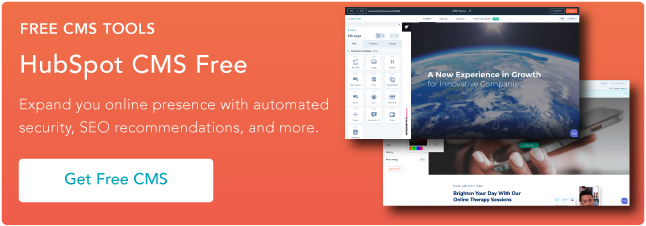












You must be logged in to post a comment Login